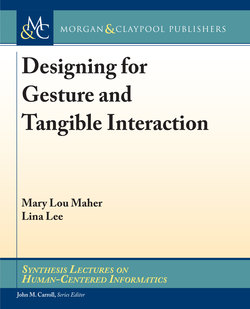Читать книгу Designing for Gesture and Tangible Interaction - Mary Lou Maher - Страница 7
На сайте Литреса книга снята с продажи.
ОглавлениеContents
Preface
Acknowledgments
1 Introduction
1.1 Embodiment
1.2 Affordance
1.3 Metaphor
1.4 Epistemic Actions
1.5 This Book
2 Tangible Interaction Design
2.1 What is a Tangible Interaction?
2.1.1 Tangible Keyboard
2.1.2 Tangible Models
2.2 Why is Tangible Interaction Interesting?
2.2.1 Space-Multiplexed Input and Output
2.2.2 Concurrency
2.2.3 Strong Specific Devices
2.2.4 Spatially Aware Computational Devices
2.2.5 Spatial Reconfigurability of Devices
2.3 What Are Key Design Issues for Tangible User Interfaces?
2.3.1 Designing Interplay of Virtual and Physical
2.3.2 Selecting from Multiple Gestures and Actions
2.3.3 Crossing Disciplinary Boundaries
2.3.4 The Lack of Standard Input and Output Interaction Models
3 Designing for Tangible Interaction
3.1 Designing the Tangible Keyboard
3.1.1 Context of Use
3.1.2 Design Goals
3.1.3 Technology Selection
3.1.4 Design Methods
3.1.5 Interaction Model
3.1.6 Design Heuristics
3.2 Designing Tangible Models
3.2.1 Context of Use
3.2.2 Design Goals
3.2.3 Technology Selection
3.2.4 Design Methods
3.2.5 Interaction Model
3.2.6 Design Guidelines
4 Gesture-based Interaction
4.1 What Is a Gesture-based Interaction?
4.1.1 Gesture Commands: Walk-Up-and-Use Information Display
4.1.2 Gesture dialogue: The Willfull Marionette
4.2 Why is Gesture-based Interaction Interesting?
4.2.1 Public Walk-Up-and-Use Displays or Objects
4.2.2 Remote Actuators, Sensors, and Displays
4.2.3 Sociable Multiple-User Interaction
4.2.4 Gesture Communication
4.3 What Are Key Design Issues for Gesture-based Interaction?
4.3.1 Considering How to Engage People
4.3.2 Designing Clear and Consistent Visual Feedback
4.3.3 Selecting Ergonomic Gestures
4.3.4 Designing Discoverable Gestures
4.3.5 Inaccurate Gesture Recognition
5 Designing for Gesture Interaction
5.1 Designing the Walk-Up-and-Use Information Display
5.1.1 Context of Use
5.1.2 Design Goals
5.1.3 Technology Selection
5.1.4 Design Methods
5.1.5 Interaction Model
5.1.6 Design Heuristics
5.2 Designing the Willful Marionette
5.2.1 Context of Use
5.2.2 Design Goals
5.2.3 Technology Selection
5.2.4 Design Methods
5.2.5 Interaction Model
5.2.6 Design Guidelines
6 Looking to the Future: Research Challenges
6.1 Design Challenges for Embodied Interaction
6.1.1 Understanding Embodied Actions as User Input
6.1.2 Designing Gestures with Effective Visual Feedback
6.1.3 Understanding Sensing Technology
6.2 Research Challenges for Embodied Interction
6.2.1 Gesture Design
6.2.2 Multidisciplinary Research
6.2.3 Finding Appropriate Contexts of Use
6.2.4 Limited Scope of Representation
6.2.5 Cognitive and Physical Fatigue
Bibliography
Authors’ Biographies
